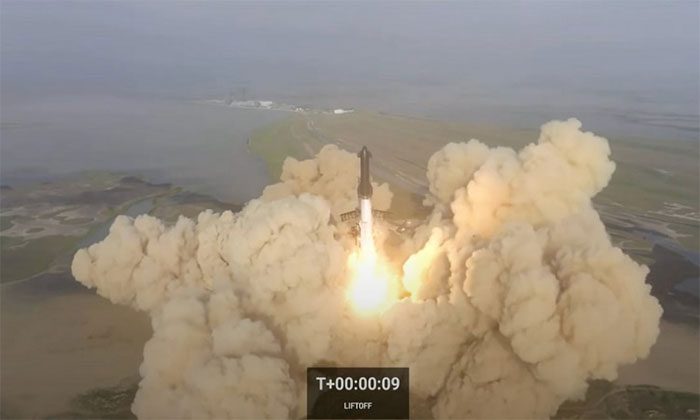The Starship rocket exploded in the Texas sky shortly after departing from the launch pad during its first flight into space.
The Starship rocket exploded mid-air. (Video: SpaceX)
The most powerful rocket ever built lifted off from SpaceX’s Starbase facility in Boca Chica Beach, South Texas, at 9:33 AM local time on April 20 (10:33 PM on April 20 in Hanoi). Standing 120 meters tall, Starship launched into orbit after firing up 33 Raptor engines in its first stage, ascending steadily with its shiny stainless steel body against the Texas sky.
According to the flight plan, the 50-meter upper stage of Starship was expected to separate from the Super Heavy booster approximately 3 minutes after launch, but that did not occur. The two vehicles remained attached, began to wobble, and ultimately exploded just 4 minutes post-launch. According to SpaceX, the duo experienced a “rapid unscheduled disassembly.”
However, employees gathered at SpaceX’s headquarters in Hawthorne, California, to monitor the launch process still cheered for the achievements made during the first launch. The massive vehicle system reached a maximum altitude of about 39 kilometers, according to data from SpaceX. This was SpaceX’s second attempt to launch Starship; the first test on April 17 ended abruptly due to a frozen valve.
According to the flight plan, Super Heavy would return to Earth, landing in the Gulf of Mexico about 8 minutes after launch. Meanwhile, the upper stage was supposed to ignite 6 Raptor engines to reach its destination and fly partially around the Earth. SpaceX aimed to get Starship to a maximum altitude of 233 kilometers, then return to Earth’s atmosphere and land in the Pacific Ocean about 90 minutes after liftoff, not far from Kauai, Hawaii.

The Starship rocket departs from the launch pad.
However, SpaceX did not expect everything to go smoothly. New rockets often fail during their first test flights. Starship is larger and more complex than most launch vehicles. Today’s flight was intended to gather data and respond effectively to any incidents, according to a company representative.
Starship consists of a first-stage booster called Super Heavy and an upper stage also named Starship. Both vehicles are designed for complete reusability, a key breakthrough for missions to Mars. The components of Starship launched today are the Super Heavy Booster 7 prototype and the upper stage named Ship 24, which will not fly again as SpaceX has no plans to recover the vehicles at sea. SpaceX’s new Raptor engines operate on methane and liquid oxygen—fuels that can be produced on the Red Planet, allowing Starship to launch effectively from both Mars and Earth.
Musk envisions Starships flying multiple times a day on Earth. The Super Heavy booster would return directly to the launch pad after each liftoff for quick inspections, refueling, and subsequent launches. Enhanced reusability could reduce the cost of each Starship mission to a few million USD, according to Musk. Starship can carry 165 tons to low Earth orbit on each mission in a reusable configuration. The 33 Raptor engines of Super Heavy generate approximately 16.5 million pounds of thrust at liftoff, nearly doubling the previous record held by NASA’s Space Launch System, which first flew last November during the Artemis 1 Moon mission.


















































